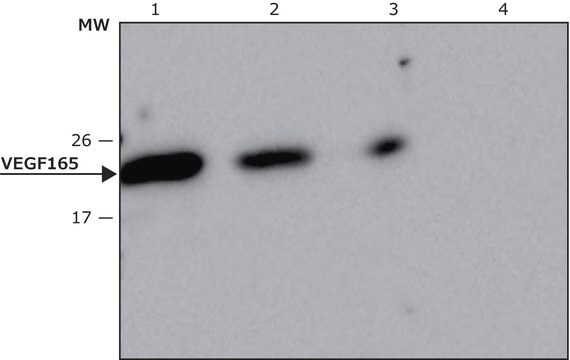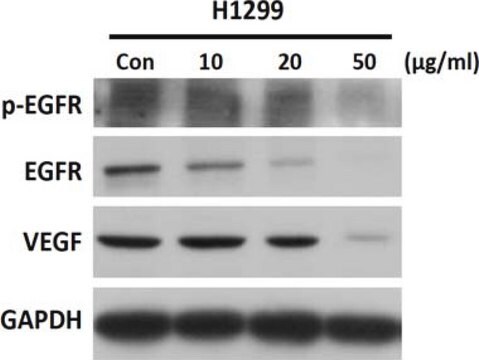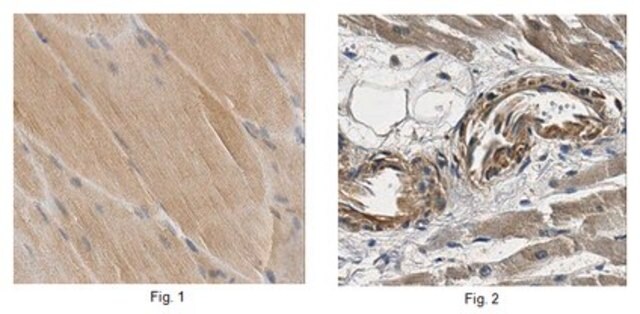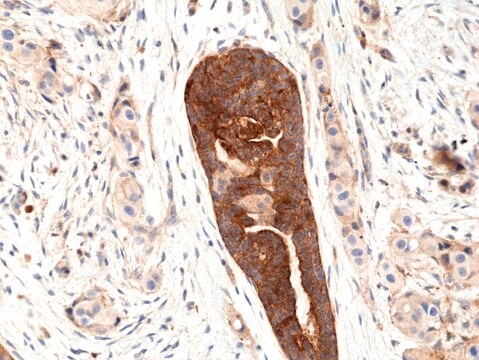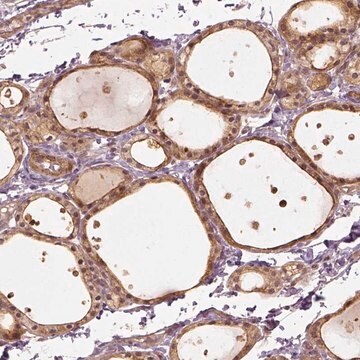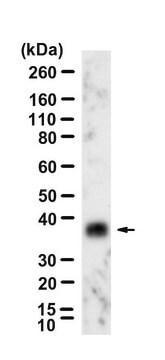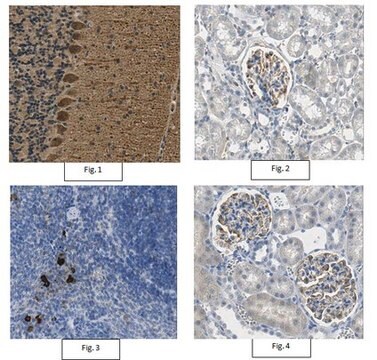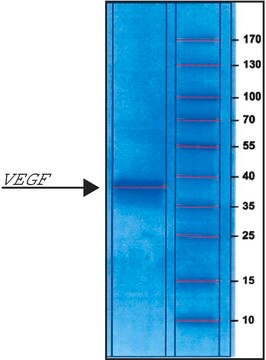MABC595
Anti-VEGF 165b Antibody, clone 56/1
clone 56/1, 1 mg/mL, from mouse
Synonim(y):
Vascular endothelial growth factor 165b, Vascular endothelial growth factor 165, Vascular endothelial growth factor A, Vascular permeability factor
About This Item
Polecane produkty
pochodzenie biologiczne
mouse
Poziom jakości
forma przeciwciała
purified antibody
rodzaj przeciwciała
primary antibodies
klon
56/1, monoclonal
reaktywność gatunkowa
human, mouse, rat
stężenie
1 mg/mL
metody
ELISA: suitable
immunohistochemistry: suitable
western blot: suitable
izotyp
IgG1κ
numer dostępu NCBI
numer dostępu UniProt
Warunki transportu
wet ice
docelowa modyfikacja potranslacyjna
unmodified
informacje o genach
human ... VEGFA(7422)
Opis ogólny
Immunogen
Zastosowanie
Apoptosis & Cancer
Apoptosis - Additional
Immunohistochemistry Analysis: A 1:50 dilution of a representative lot detected detected VEGF 165b in tumor cells of human prostate cancer tissue.
Western Blotting Analysis: A representative lot detected recombinant VEGF 165b protein (Woolard, J., et al. (2004) CANCER RESEARCH 64:7822–7835).
Western Blotting Analysis: A representative lot detected VEGF 165b in human eye tissue lysate (Perrin, R.M., et al. (2005) Diabetologia. 48: 2422–2427).
Immunohistochemistry Analysis: A representative lot detected VEGF 165b in Mouse mesentery tissue (Woolard, J., et al. (2004) CANCER RESEARCH 64:7822–7835).
Immunohistochemistry Analysis: A representative lot detected VEGF 165b in tumor tissue sections (Peiris-Pagès, M., et al. (2010) Pathol. 222(2): 138–147).
ELISA: A representative lot of this antibody detected VEGF 165b by ELISA on tumor tissue samples & tumor cell lines (Peiris-Pagès, M., et al. (2010) Pathol. 222(2): 138–147).
ELISA: A representative lot of this antibody detected VEGF 165b by ELISA on recombinant protein VEGF 165b (Woolard, J., et al. (2004) CANCER RESEARCH 64:7822–7835).
Jakość
Western Blotting Analysis: 2 µg/mL of this antibody detected VEGF 165b in 10 µg of NIH/3T3 cell lysate.
Opis wartości docelowych
Additional uncharacterized bands may be visible in some lysates.
Postać fizyczna
Przechowywanie i stabilność
Oświadczenie o zrzeczeniu się odpowiedzialności
Nie możesz znaleźć właściwego produktu?
Wypróbuj nasz Narzędzie selektora produktów.
Kod klasy składowania
12 - Non Combustible Liquids
Klasa zagrożenia wodnego (WGK)
WGK 1
Temperatura zapłonu (°F)
Not applicable
Temperatura zapłonu (°C)
Not applicable
Certyfikaty analizy (CoA)
Poszukaj Certyfikaty analizy (CoA), wpisując numer partii/serii produktów. Numery serii i partii można znaleźć na etykiecie produktu po słowach „seria” lub „partia”.
Masz już ten produkt?
Dokumenty związane z niedawno zakupionymi produktami zostały zamieszczone w Bibliotece dokumentów.
Nasz zespół naukowców ma doświadczenie we wszystkich obszarach badań, w tym w naukach przyrodniczych, materiałoznawstwie, syntezie chemicznej, chromatografii, analityce i wielu innych dziedzinach.
Skontaktuj się z zespołem ds. pomocy technicznej